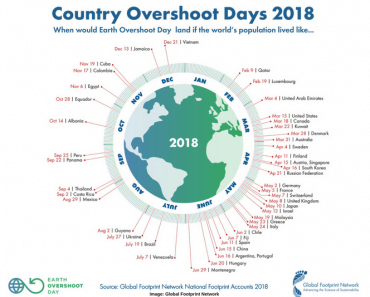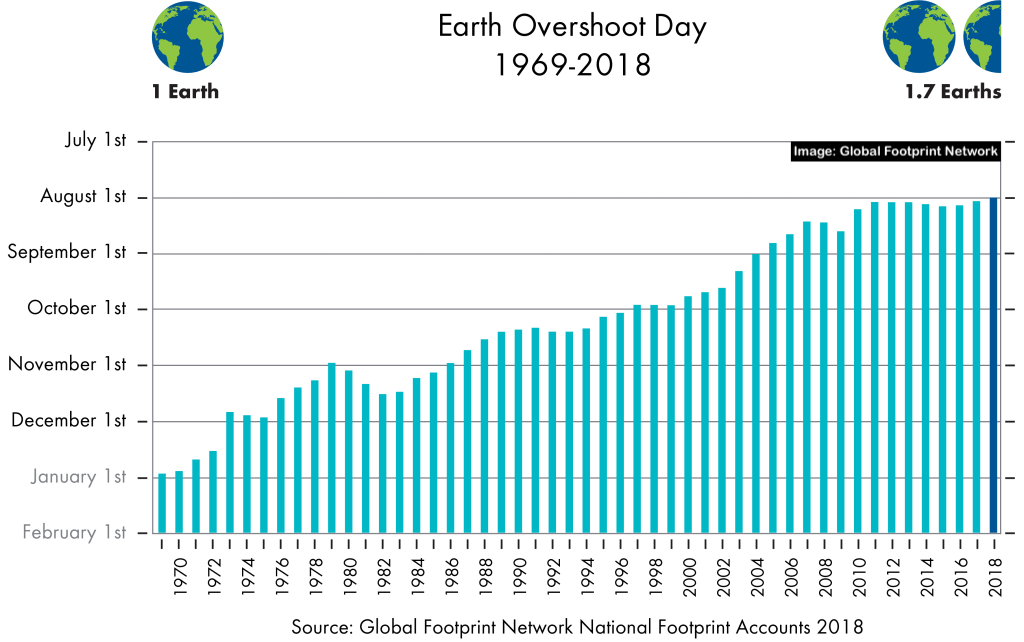Earth Overshoot Day, the date that marks when humanity has consumed more resources than the earth’s ecosystems can replenish in a year, has fallen on August 1 this year — the earliest ever.
According to Global Footprint Network, humans are using earth’s resources 1.7 times faster than the planet can regenerate. Essentially, in 2018, we are on track to use 1.7 earths.
“As we mark Earth Overshoot Day, today may seem no different from yesterday — you still have the same food in your refrigerator,” Mathis Wackernagel, CEO of Global Footprint Network, said in a statement.
“But fires are raging in the Western United States. On the other side of the world, residents in Cape Town have had to slash water consumption in half since 2015. These are consequences of busting the ecological budget of our one and only planet.”
Every year, Global Footprint Network calculates Earth Overshoot Day by adding up people’s demand for nature. This includes absorption of carbon emissions from fossil fuels, demand for food, cotton and timber, and construction of buildings, roads and infrastructure.
Humans forced the first Earth Overshoot Day in the 1970s. August 1 is the earliest it has ever occured, hopefully serving as a real wake-up call.
According to Global Footprint Network, “the data shows unequivocally that humanity’s demand on nature is at an unsustainable level — one year is no longer enough to regenerate humanity’s annual demand on the planet, even using conservative data sets that underestimate the gap between how much humans use compared to what nature can renew.”
Raising awareness
Global Footprint Network and its partners have organized activities all over the world to raise awareness.
In New York City, a video featuring footage by cinematographer Louie Schwartzberg is running in Times Square from July 20 to August 3.
On July 24, Global Footprint Network aired a webinar titled “Living on a Finite Planet: Strategies for Sustainable Resource Utilization,” from Oakland, California, and Paris.
On the morning of August 1, Inkota, Germanwatch and other partners held a large press conference in Berlin.
On August 1, In Rio de Janeiro, the Museu do Amanhã showed a screening of a documentary film about the cattle invasion in the Amazon called “Under the Ox Paw.”
Global Footprint Network also created the hashtag #MoveTheDate to livestream events and for people to share stories and raise awareness.
Solutions
The Global Footprint Network identified four key solution areas — energy, cities, food and population.
If we can reduce the carbon in humanity’s ecological footprint by 12 percent, Earth Overshoot Day could fall back 93 days.
If, in cities, humans can reduce driving by 50 percent and replace a third of the miles traveled in a car with public transportation, Earth Overshoot Day could be moved back 12 days.
If humans cut all food waste in half, consume world-average calories and lower the “footprint intensity” of their diets, Earth Overshoot Day could be moved back 38 days.
Lastly, if half of the world’s families had one less child, Earth Overshoot Day could fall back 30 days.
Carbon footprint
According to Global Footprint Network, the carbon footprint makes up 60 percent of the total ecological footprint. The problem is, the total carbon footprint has more than doubled since 1970.
Our carbon footprint is what is driving climate change. Carbon dioxide is being pumped into the air at much faster rates than it can be absorbed, so it is building up in the ocean and atmosphere. Reducing the footprint is a necessary step in ending ecological overshoot and fighting climate change.
Fortunately, efforts have been taken to reduce the global carbon footprint.
A climate agreement at the United Nations Conference of Parties (COP) 21 in December 2017 mandated that nations implement policies to phase out fossil fuels by 2050.
The Paris Agreement, ratified in 2016, is a worldwide initiative created to strengthen the global response to the threat of climate change.
Although the U.S. — one of the leading contributors to carbon emissions — backed out of the Paris Agreement, many of the universities and businesses proclaimed: “We Are Still In!”
“We have no choice but to fight back with everything we have. To state the obvious, the planet depends on it,” Kathleen Merrigan, executive director of sustainability at George Washington University and former U.S. deputy secretary and chief operating officer of the U.S. Department of Agriculture, previously told TUN.
“The Paris Agreement, ratified in 2016 by nearly every country on earth after years of debate, is an important start to this essential process,” Michael Crow, president of Arizona State University, previously told TUN.
“We all want a planet capable of supporting our dreams for the future and what we now know is that this cannot be accomplished one country at a time.”
Conclusion
If humanity fails to reverse the forward trend of Earth Overshoot Day, ecosystems will start falling apart. The earth can only last so long.
“Our economies are running a Ponzi scheme with our planet,” Wackernagel said in a statement.
“We are using the Earth’s future resources to operate in the present and digging ourselves deeper into ecological debt. It’s time to end this ecological Ponzi scheme and leverage our creativity and ingenuity to create a prosperous future free of fossil fuels and planetary destruction.”




